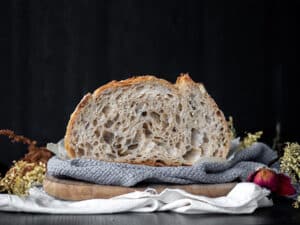For the consumer, a consistently uniform, attractive and well-shaped loaf is a guarantee of quality and of the baker’s expertise.
During mixing, the knotted strands of gluten are unravelled and woven together to form the gluten network that will trap the CO2 gases produced by fermentation. During the formation of this network, redox reactions create disulphide bonds within the gluten proteins largely responsible for the viscoelastic properties of dough, boosted by the introduction of air during mixing and by the presence of oxidisers, such as ascorbic acid.
The consequences of excess dough maturation
- extended smoothing time of dough,
- difficulty or impossibility of insertion into automatic divider,
- shaping problems due to shrinking (short baguettes), uneven results (oval-shaped pizzas or laminated dough discs), dough tearing easily or sheets too thin for lamination.
All these constraints can end in a flat, misshapen finished product or irregular results.
Improved extensibility can help reduce, if not eliminate dough shrinkage
Deactivated yeast for improved machinability, extensibility and shaping
What is deactivated yeast?
Deactivated yeast is obtained from live yeast that has undergone a specific fermentation procedure and thermal treatment. This inhibits its fermentation power and destroys its cell walls, thereby rendering the glutathione content available and soluble in its environment. Deactivated yeast is therefore a product of natural origin. Under the regulations, it is therefore not regarded as a food additive and its labelling varies depending on the country (i.e. “yeast” or “deactivated fermenting agent”).
How does it work?
Deactivated yeast is rich in tripeptides naturally present in yeast. This reduces the number of strong bonds between the protein macromolecules and consequently facilitates sliding between them. This effect is visible from the start of the mixing process and at every stage in the procedure with the following results:
- reduced mixing time and lower oxidation due to faster dough smoothing process;
- easy insertion into divider and more even dough balls due to inhibited dough maturation during first rise;
- shaping/lamination made easy due to increased extensibility and reduced elasticity. Shrinkage phenomena are thus avoided, and the rest time between folding stages is shortened and presentation on the automated lines is more regular;
- optimised volume (dough extensibility reduces resistance to gaseous thrust).
Lesaffre deactivated yeast minimises the formation of disulphide bonds between the gluten strands. The gluten protein chains glide more easily between each other, thereby increasing volume and reducing shrinkage.
Proteases to be used with caution
Proteases, whether of bacterial or fungal origin, are permitted in certain bakery applications as a technological aid. They are commonly used in the production of sandwich bread and buns, which require a very soft dough when placing in moulds. They are also used for the manufacture of crackers, biscuits or wafers, which would otherwise be adversely affected by excessive elasticity. Proteases, which work by hydrolysing gluten, should nonetheless be handled with care: they act on the gluten substrate continuously throughout the process until the enzymes are denatured during baking. A lack of knowledge of their use can result in liquefied dough, especially on automated production lines.
Lesaffre solution
- with deactivated yeast, a natural reducing agent rich in glutathione, which is used to obtain a more voluminous end product and more uniform quality. Furthermore, deactivated yeast makes it possible to obtain less irregular dough extrusions;
- with L-cystéine, a reducing agent of animal or bacterial origin, which has the same operating principle as deactivated yeast. Unlike yeast, L-cysteine is a food additive (E920). Some countries do not permit its use. Using such a concentrated product requires precise dosing and therefore specific equipment;
- neutral bases, thus facilitating doses compatible with the environment,
- or as mixes, which at once helps to optimise doses, by acting on the synergies existing between the active principles, and better regulate the potentially undesirable effect of using pure substances.




